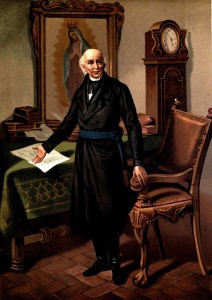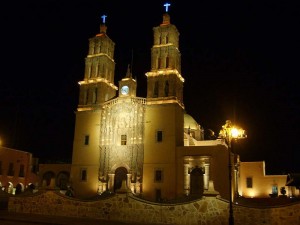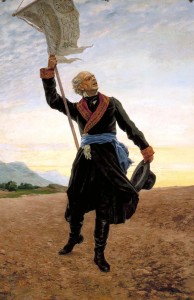| Miguel Hidalgo y Costilla | |
|---|---|
 |
|
| Father of Mexican Independence | |
| In Power | 1809-1811 |
| Born | May 8, 1753 Penjamo |
| Died | July 30, 1811 Chihuahua |
| Nationality | Spanish |
| Caste | Creole |
Miguel Hidalgo y Costilla retained power between 1809 and 1811 as a revolutionary Mexican priest. He was considered to be among the foremost individuals in regards to the realization of Mexican independence. He is known for leading a revolt against Spanish rule, triggering a sequence of political episodes and military activities which laid the foundations for the achievement of Mexican independence in 1821.
Miguel was born in 1753, the second child out of the eleven of an estate administrator by the name Don Cristóbal Hidalgo y Costilla. Together with his elder brother, they attended a school in their home which was operated by the Jesuits and decided to take up priesthood. After completing their junior studies, they traveled to Valladolid, present day Morelia, where they joined a school in San Nicolás Obispo to continue their studies. While in San Nicolás, Miguel distinguished himself from other students as one of the top students in his class. After finishing his studies, he became the rector of this school and was regarded as a great theologian of the school. In 1803, after the death of his older brother, Miguel joined the priesthood by replacing his brother as the cleric of Dolores.
Despondency
Hidalgo had a strong belief that the Spanish leadership was a tyrannical. He therefore organized a series of gatherings at his home to speak with the local people and teach them trades and farming techniques. At the same time, plans for independence were being held at Querétaro. However, the rebellion needed a leader who had moral authority and good connections with the inferiors in the country. Hidalgo, having all these qualities, was recruited to lead the plot.
The Cry of Dolores
 On September 15, 1810, word came to Hidalgo that their intentions had been compromised. At the time, Hidalgo was in Dolores with a military commander by the name of Ignacio Allende. On the reception of this information, he rang the bells of the church the next morning to call all the people to the church. He announced his intention to fight for independence at the pulpit and encouraged the Dolores people to join him. Within a few minutes, he had inspired an army of 600 men, with his sermon immortalized as the “Cry of Dolores.”
On September 15, 1810, word came to Hidalgo that their intentions had been compromised. At the time, Hidalgo was in Dolores with a military commander by the name of Ignacio Allende. On the reception of this information, he rang the bells of the church the next morning to call all the people to the church. He announced his intention to fight for independence at the pulpit and encouraged the Dolores people to join him. Within a few minutes, he had inspired an army of 600 men, with his sermon immortalized as the “Cry of Dolores.”
The Siege of Guanajuato
Hidalgo and Allende led their growing army to the towns of Celaya and San Miguel where they killed any Spaniard they found on the way and sacked their homes. They reached the city of Guanajuato on the 28th of September. The forces of Spain and other royalists had fortified themselves in the public barn. The battle was brutal, as the army of rebels, totaling 30,000 men, overran the barricade and killed 500 Spaniards inside the silo. Afterwards, they looted the towns of Guanajuato.
Mount of Crosses
Hidalgo’s army grew to more than 80,000 men as they marched towards Mexico City. A strong defense was organized by the viceroy, and leadership was given to General Torcuato Trujillo. The defense force consisted of 1,000 men, 2 cannons and 400 horsemen. The battle began on October 30, 1810, on the Mount of the Crosses (Monte de las Cruses), with the royalists fighting bravely as a young officer by the name Agustin de Iturbide distinguished himself. Hidalgo’s forces defeated the Royalists but decided not to advance further.
Retreat
Although Hidalgo had the advantage of numbers, he retreated after defeating the royalist army at Monte de las Cruses. Historians are not sure what led to this decision, however, there are a few theories. Some believe that he dreaded the principal army of the royalists led by General Felix Calleja while others say that he sought to spare the lives of the Mexican citizens.
The Bridge of Calderon
After retreating, the rebel army divided in two with Hidalgo heading to Guadalajara and Allende to Guanajuato. They reunited after Allende lost the city and the Spanish army led by General Felix Calleja engaged them in the Battle of Calderón Bridge on January 17, 1811. The Calleja army was outnumbered but got lucky when a cannonball exploded, causing the rebel soldiers to break.
The Betrayal and Execution of Hidalgo
Hidalgo and Allende were forced to run north towards the U.S. with hopes of attaining weapons and mercenaries. However, a local by the name Ignacio Elizondo betrayed them, leading to their capture. They were handed over to Spanish authorities and taken to Chihuahua for trials.
 All the leaders of the rebel were found guilty and sentenced to death. Only Mariano Abasolo was sentenced to life imprisonment and sent to Spain. Aldama, Allende, and Jiménez were shot in the back as a symbol of dishonor on June 26, 1811. Hidalgo, however, had to undergo a civil trial to be stripped of his priesthood. After being found guilty, he was executed on July 30th. The heads of Jiménez, Aldama, Allende, and Hidalgo were conserved and hung on the 4 corners of Guanajuato granary to warn any rebels of the repercussions of moving against the Royalists.
All the leaders of the rebel were found guilty and sentenced to death. Only Mariano Abasolo was sentenced to life imprisonment and sent to Spain. Aldama, Allende, and Jiménez were shot in the back as a symbol of dishonor on June 26, 1811. Hidalgo, however, had to undergo a civil trial to be stripped of his priesthood. After being found guilty, he was executed on July 30th. The heads of Jiménez, Aldama, Allende, and Hidalgo were conserved and hung on the 4 corners of Guanajuato granary to warn any rebels of the repercussions of moving against the Royalists.
Hidalgo’s Legacy
Father Hidalgo is celebrated as the father of Mexico. He is considered a great hero in Mexico’s fight for independence.
Even after his death, Hidalgo’s role was still relevant in the rebellion. His death paved the way for others to continue the fight for independence and freedom. He influenced many people including Guadalupe Victoria and José María Morelos. Presently, his remains have been preserved at the Mexico City monument under the title, “The Angel of Independence.”